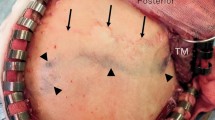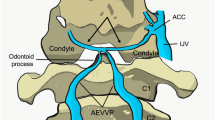Abstract
Background
The calvarial diploic venous channels (CDVCs) are well-known intraosseous structures, but their distribution and anatomofunctional implications are not fully understood.
Objective
To investigate the architecture of CDVCs using high-resolution magnetic resonance (MR) imaging.
Method
This prospective study enrolled 43 male and 37 female outpatients who underwent a 3.0-T MR imaging equipped by a 32-channel head coil. T1-weighted imaging covering the whole cranial vault was performed after gadolinium injection. In addition, one-piece orbitozygomatic craniotomy was performed in three cadaveric heads to observe the interruption of the CDVCs.
Results
The CDVCs showed irregular contours and peculiar branching patterns with four common major pathways: the pteriofrontparietal (PFP), frontoorbital (FO), occipitoparietal (OP), and occipitocervical (OC) routes. The proximal PFP coursed as a single trunk and divided into several branches at the level of the frontal eminence. The orbital part of the FO continued to the subcutaneous vein via the supraorbital rim. The PFP and the pterional part of the FO fused proximally with the sphenoparietal sinus and descended as the middle meningeal vein. The OP coursed in the superoinferior direction and connected the junction part of the transverse-sigmoid sinus to the parietal superior sagittal sinus. The OC occurred as a single trunk in the median occipital bone, drained extracranially, and joined the suboccipital venous channels.
Conclusions
The CDVCs seem to be a relatively consistent network functioning not only as conduits connecting the intracranial dural sinuses but also as pathways to the extracranial venous systems. High-resolution MR imaging is useful for investigating the CDVCs.







Similar content being viewed by others
References
Benndorf G, Lehmann TN (2004) Bilateral diploic arteriovenous fistula causing scalp hematoma. J Neurosurg 100:950–955
Burger IM, Tamargo RJ, Broussard J, Gailloud P (2005) Combined surgical and endovascular treatment of a spontaneous diploic arteriovenous fistula. Case report. J Neurosurg 103:179–181
García-González U, Cavalcanti DD, Agrawal A, Gonzalez LF, Wallace RC, Spetzler RF, Preul MC (2009) The diploic venous system: surgical anatomy and neurosurgical implications. Neurosurg Focus 27:E2
Hershkovitz I, Greenwald C, Rothschild BM, Latimer B, Dutour O, Jellema LM, Wish-Baratz S, Pap I, Leonetti G (1999) The elusive diploic veins: anthropological and anatomical perspective. Am J Phys Anthropol 108:345–358
Jefferson G, Stewart D (1928) On the veins of the diplö. Brit J Surg 16:70–88
Jivraj K, Bhagava R, Aronyk K, Quateen A, Walji A (2009) Diploic anatomy studied in vivo by MRI. Clin Anat 22:296–301
Johnston KD, Walji AH, Fox RJ, Pugh JA, Aronyk KE (2007) Access to cerebrospinal fluid absorption sites by infusion into vascular channels of the skull diplö. J Neurosurg 107:841–843
Mortazavi MM, Tubbs RS, Riech S, Verma K, Shoja MM, Zurada A, Benninger B, Loukas M, Cohen Gadol AA (2012) Anatomy and pathology of the cranial emissary veins: a review with surgical implications. Neurosurgery 70:1312–1319
Ohigashi Y, Tanabe A (2001) A huge frontal meningioma associated with intraoperative massive bleeding and severe brain swelling—case report. J Clin Neurosci 8(Suppl 1):54–58
Reis CV, Deshmukh V, Zabramski JM, Crusius M, Desmukh P, Spetzler RF, Preul MC (2007) Anatomy of the mastoid emissary vein and venous system of the posterior neck region: neurosurgical implications. Neurosurgery 61:193–201
Rizvi M, Behari S, Singh RK, Gupta D, Jaiswal AK, Jain M, Phadka RV (2010) Sinus pericranii with unusual features: multiplicity, associated dural venous lakes and venous anomaly, and a lateral location. Acta Neurochir (Wien) 152:2197–2204
San Millán Ruíz D, Fasel JH, Rüfenacht DA, Gailloud P (2004) The sphenoparietal sinus of breschet: does it exist? An anatomic study. AJNR Am J Neuroradiol 25:112–120
Shim JH, Yoon SM, Shim JJ, Kim RS (2011) A case of intraosseous dural arteriovenous fistulas involving diploic vein treated with transarterial onyx embolization. J Korean Neurosurg Soc 50:260–263
Toriumi H, Shimizu T, Shibata M, Unekawa M, Tomita Y, Tomita M, Suzuki N (2011) Developmental and circulatory profile of the diploic veins. Microvasc Res 81:97–102
Tsutsumi S, Yasumoto Y, Ito M (2011) Case of calvarial fibrous dysplasia presenting with cyst degeneration [Japanese]. No Shinkei Geka 39:163–168
Tubbs RS, Salter EG, Wellons JC 3rd, Blount JP, Oakes WJ (2007) The sphenoparietal sinus. Neurosurgery 60(2 Suppl 1):ONS9-12
Acknowledgments
This work did not receive any grant. We thank Professor AL Rhoton Jr for supporting the cadaveric study in the present work performed at the Department of Neurological Surgery, University of Florida, Gainesville, Florida, USA.
Conflict of interest
The authors have no conflict of interest concerning the materials or methods used in this study or the findings specified in this paper.
Author information
Authors and Affiliations
Corresponding author
Rights and permissions
About this article
Cite this article
Tsutsumi, S., Nakamura, M., Tabuchi, T. et al. Calvarial diploic venous channels: an anatomic study using high-resolution magnetic resonance imaging. Surg Radiol Anat 35, 935–941 (2013). https://doi.org/10.1007/s00276-013-1123-3
Received:
Accepted:
Published:
Issue Date:
DOI: https://doi.org/10.1007/s00276-013-1123-3




